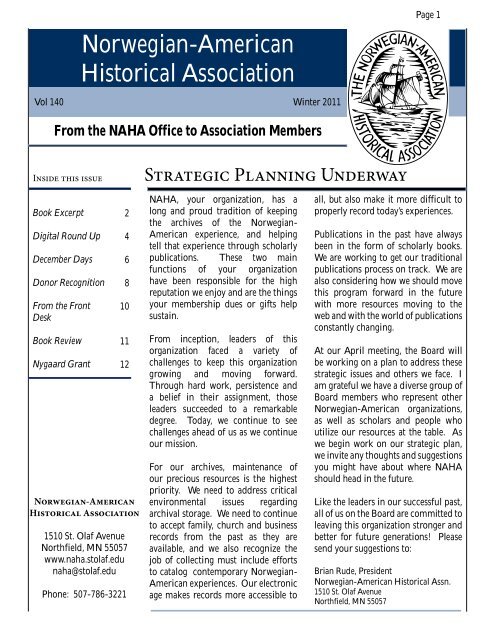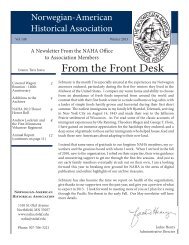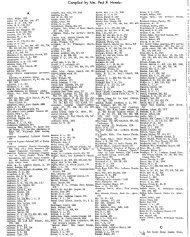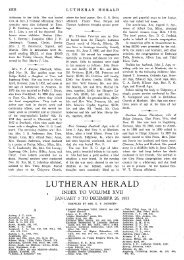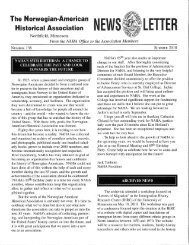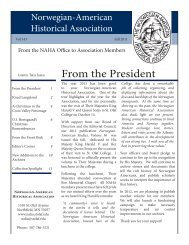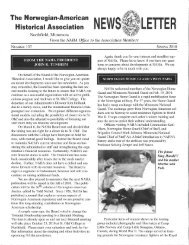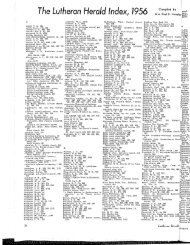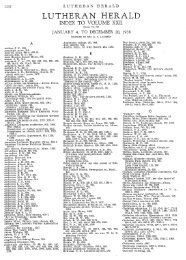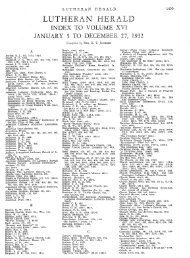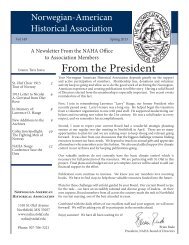Winter 2011 - Norwegian-American Historical Association - St. Olaf ...
Winter 2011 - Norwegian-American Historical Association - St. Olaf ...
Winter 2011 - Norwegian-American Historical Association - St. Olaf ...
You also want an ePaper? Increase the reach of your titles
YUMPU automatically turns print PDFs into web optimized ePapers that Google loves.
<strong>Norwegian</strong>-<strong>American</strong><strong>Historical</strong> <strong>Association</strong>Page 1Vol 140 <strong>Winter</strong> <strong>2011</strong>From the NAHA Office to <strong>Association</strong> MembersI ; @ U P 2 A T U @ U @ @ B 2S A ? . A 2 S U O P 9 . ; ; U ; S U ; P 2 ? D . FBook ExcerptDigital Round UpDecember DaysDonor RecognitionFrom the FrontDeskBook ReviewNygaard Grant2468101112N < ? D 2 4 6 . ; - A : 2 ? 6 0 . ;H 6 @ A < ? 6 0 . 9 A @ @ < 0 6 . A 6 < ;1510 <strong>St</strong>. <strong>Olaf</strong> AvenueNorthfield, MN 55057www.naha.stolaf.edunaha@stolaf.eduPhone: 507-786-3221NAHA, your organization, has along and proud tradition of keepingthe archives of the <strong>Norwegian</strong>-<strong>American</strong> experience, and helpingtell that experience through scholarlypublications. These two mainfunctions of your organizationhave been responsible for the highreputation we enjoy and are the thingsyour membership dues or gifts helpsustain.From inception, leaders of thisorganization faced a variety ofchallenges to keep this organizationgrowing and moving forward.Through hard work, persistence anda belief in their assignment, thoseleaders succeeded to a remarkabledegree. Today, we continue to seechallenges ahead of us as we continueour mission.For our archives, maintenance ofour precious resources is the highestpriority. We need to address criticalenvironmental issues regardingarchival storage. We need to continueto accept family, church and businessrecords from the past as they areavailable, and we also recognize thejob of collecting must include effortsto catalog contemporary <strong>Norwegian</strong>-<strong>American</strong> experiences. Our electronicage makes records more accessible toall, but also make it more difficult toproperly record today’s experiences.Publications in the past have alwaysbeen in the form of scholarly books.We are working to get our traditionalpublications process on track. We arealso considering how we should movethis program forward in the futurewith more resources moving to theweb and with the world of publicationsconstantly changing.At our April meeting, the Board willbe working on a plan to address thesestrategic issues and others we face. Iam grateful we have a diverse group ofBoard members who represent other<strong>Norwegian</strong>-<strong>American</strong> organizations,as well as scholars and people whoutilize our resources at the table. Aswe begin work on our strategic plan,we invite any thoughts and suggestionsyou might have about where NAHAshould head in the future.Like the leaders in our successful past,all of us on the Board are committed toleaving this organization stronger andbetter for future generations! Pleasesend your suggestions to:Brian Rude, President<strong>Norwegian</strong>-<strong>American</strong> <strong>Historical</strong> Assn.1510 <strong>St</strong>. <strong>Olaf</strong> AvenueNorthfield, MN 55057
Page 2 Volume 140B < < 8 E E O 2 ? = A -“The role of the foreignlanguagepress in general andthe <strong>Norwegian</strong>-language pressin particular has held a specialscholarly fascination for me sincethe late 1960s, when I wrote mymaster’s thesis on the <strong>Norwegian</strong>immigrant press in North Dakotabased on the extensive holdingsof the Chester Fritz Library at theUniversity of North Dakota inGrand Forks. The newspapers’yellowing pages printed inGothic script and and archaicDano-<strong>Norwegian</strong> linguistic formwere intriguing and engrossingsources to the understanding ofthe immigrant world of bygonedays. Their perusual becameand engaging and stimulatingexperience.”-Odd Lovoll, Preface andAcknowledgements, <strong>Norwegian</strong>Newspapers in America:Connecting Norway and the NewLandA NationalCommunicationsNetworkN < ? D 2 S U . ; N 2 D @ = . = 2 ? @“It was a foregone conclusion,”stated Kenneth Bjork, “thatwhere <strong>Norwegian</strong>s—alone or incombination with Danes—wereat all numerous, someone witha bit of capital would organizea publishing company and putout a newspaper in the Danish-<strong>Norwegian</strong> language”. Manyjournals as a consequence sawthe light of day in small and largetowns and in large metropolitanareas; most perished very shortly.The least successful ventures wereoften partisan journals publishingto promote a specific cause orpolitical candidacy. Expectationsof success were frequentlyunrealistic given rival publicationsand limited numbers of potentialsubscribers. Means to begin anewspaper might come fromsupporting groups and individuals,or as the present chapter suggests,were accumulated by immigrantprinters, who might in addition topublishing a <strong>Norwegian</strong>-languagejournal print other jobs on theside. Success escaped the majority.The initial challenge was to enticesubscribers, then to convincethem to honor the annualsubscription fee. The publishersput forth compelling bonusesfor new subscribers, lowered thesubscription price, and regularlyprinted strong editorial urgingsfor delinquent subscribers to payup.Hardships and failuresnotwithstanding, by 1900 anational interactive <strong>Norwegian</strong><strong>American</strong> press was a functioningreality; small and large journalscited each other, engaged in heatedexchanges of opinions, cooperatedand created a <strong>Norwegian</strong>-languagejournalistic network from coastto coast. The press promoted asense of a <strong>Norwegian</strong> Americathat stretched from the easternseaboard, across the Midwesternstates and Rocky Mountains,all the way to the Pacific Coast.The many newspapers informedtheir readers about <strong>Norwegian</strong>sliving in other parts of the United<strong>St</strong>ates; they carried local newsfrom a wide area. The individualnewspapers filled their columnsas well with news from the Nordichomelands and other parts of the
Page 3U ; A Y 2 ? U O . - N F D ? . O P P S . L < C < 9 9world, news frequently gleanedfrom newspapers published inNorway, or from the Yankee press,as it was referred to, and thentranslated into Dano-<strong>Norwegian</strong>.The close cooperation betweenDanish and <strong>Norwegian</strong> journals,and the many Danes who foundemployment in ostensibly<strong>Norwegian</strong> publications, preventa clear national distinction. Theimmigrant newspapers were themain source of information forindividuals lacking a readingknowledge of English; in additionto local, national, and world news,they gave advice on a great numberof issues, responded to questionsfrom their readers, and offeredspecial columns on farming,market prices, and appeals for theassistance of immigrants in need.The newspapers took part in everyaspect of the immigrants’ lives andcame to be considered personalfriends. They were distinctlydemocratic and projected apopular image.and across the bay SuperiorTidende in Wisconsin bothexercised considerable journalisticinfluence. On the East CoastNordisk Tidende surfaced as themajor news organ. Other regionalnewspapers can be included in thelist of journals with continuingservice for some length. Thepoint, however, is the reality thatthe <strong>Norwegian</strong> community inthe United <strong>St</strong>ates had access topublications in a familiar languagewherever they settled.In addition to the so-called BigThree, Skandinaven, Decorah-Posten, and Minneapolis Tidende,regional newspapers rose abovefailed competitors to become arepresentative voice. Normandenin North Dakota, Fremad in SouthDakota, and Bikuben in Utah areexamples of developments inthe <strong>Norwegian</strong> <strong>American</strong> worldof journalism. In the PacificNorthwest Washington Postensecured a prominent position;Minnesota’s Duluth SkandinavReprinted with permissionfromby Odd S. Lovoll,published by Minnesota <strong>Historical</strong>Society Press (2010).
Page 4 Volume 140D U S U A . 9 R < B ; P - U = We thought our newsletterreaders might like a round-upof the research aides and digitalrecords that have been created onthe Archives page of the NAHAweb site. We have been talkingabout these new search aides anddigital collections at meetings ofthe Board and of the membership,and we have demonstrated how touse them to a number of groups.But members who are unable toattend meetings might not befully aware of the research optionsnow available at http://www.naha.stolaf.edu/archives/index.htm.We hope you find these useful andenjoyable.Gary De Krey, ArchivistJeff Sauve, Associate ArchivistLeifLeif is our electronic searchengine. It searches most of thecollection at the file folder level. Italso includes, at the bottom of thesearch results, index entries formajor collections that have beencreated by volunteer Lee Rokke.Increase your search results byusing the <strong>Norwegian</strong> diacriticalsprovided on the search screen.Click on a particular result formore detailed “full records.” Thefull record screens can be printedand e-mailed. (The 2001 Guide tothe Archives is also available fromthe Archives web page as a PDFfile.)<strong>Norwegian</strong>-<strong>American</strong> <strong>St</strong>udiesThe first 33 published volumes ofthe <strong>St</strong>udies were digitized sometime ago. They are available intheir entirety from the Archivespage. They can be examined byvolume or by search terms ofyour choice using the NAHA sitesearch in the left-hand column ofthe page (just above the ship).<strong>Norwegian</strong>-<strong>American</strong> NespapersIndexHave you ever wondered whereto find the local <strong>Norwegian</strong>-<strong>American</strong> papers that yourimmigrant forebears read? Ourindex was created by volunteerDale Haaland and incorporatesdata gathered by Prof. Odd Lovollin preparation for his book,<strong>Norwegian</strong> Newspapers in America(Minnesota <strong>Historical</strong> SocietyPress, 2010). You can identifypapers by state and town. Youcan also use the index to connectto three electronic catalogs tofind locations for issues of thesepapers: Bridge (the electroniclibrary catalog used by <strong>St</strong>. <strong>Olaf</strong>and Carleton Colleges), WorldCat(a union electronic catalog ofmost North <strong>American</strong> academiclibraries), and the catalog of theNational Library of Norway. Andfinally, as you will read elsewherein these pages, <strong>St</strong>. <strong>Olaf</strong> is aboutto begin working on <strong>Norwegian</strong>papers for its online digitalcollections at http://www.stolaf.edu/collections/digital/. Thankyou Jill <strong>St</strong>rass, <strong>St</strong>. <strong>Olaf</strong> digitalinitiatives and metadata librarian!<strong>Norwegian</strong>-<strong>American</strong> ImagesWe are now displaying some200 digital images from theearliest generations of <strong>Norwegian</strong>settlement in Minnesota andWisconsin. We have plans toenlarge this collection gradually.You can search the images fromtheir own page (follow the linkfrom the Archives page) or youcan simply search for <strong>Norwegian</strong>-<strong>American</strong> images with your ownweb browser and our images shouldappear in your search results. Wedo ask that you not reproducethem without our permission;
Page 5and like most archives, we copyimages only upon the payment ofreproduction fees. Jill <strong>St</strong>rass hasalso been instrumental in helpingus put these images online.Hovland Index and HovlandMap IndexEvery <strong>Norwegian</strong>-<strong>American</strong> interestedin family history has hadoccasion to consult the <strong>Norwegian</strong>bygdebøker or community historybooks. But how do you find these<strong>Norwegian</strong>-language resourceswhen you know neither the titlesnor the authors’ names, or whichcommunities are adjacent? Thanksto the work of our volunteerDale Hovland, we now have twoindexes to the NAHA bygdebøkerin Rolvaag Library at <strong>St</strong>. <strong>Olaf</strong>.The first index searches for booksabout particular counties andmunicipalities with words; thesecond searches with maps. Mapsearches should prove helpfulwhen boundaries of adjacent areashave changed over time or whenfamilies have been spread outbetween adjacent localities. Theseindexes were also created with thehelp of Dale Haaland. Visitorswishing to use bygdebøker inRolvaag Library will now findmost of them on the first floor,rather than in their old locationon the fifth floor.Family history researchers willalso find useful resources onthe web site of Rolvaag Library.Reference Librarian and ProfessorKris Macpherson has created abibliographical guide to “FindingFamily Members, Farms, andCommunities in Norway” athttp://libraryguides.stolaf.edu/<strong>Norwegian</strong>Roots. Another guideto “<strong>Norwegian</strong> Genealogy andHistory in Rølvaag MemorialLibrary” can be found athttp://www.stolaf.edu/library/instruction/bibs/norwegenealogy.html. Finally, a sample of<strong>Norwegian</strong>-<strong>American</strong> imprints inthe library can be found at http://www.stolaf.edu/library/libinfo/noramimp/EReligion.html.And there is more to come! DaleHaaland has created a generaldigital index to the LutheranHerald, 1906-1960, whichshould appear soon. We havediscussed creating an onlineindex to the Rowberg obituariesof <strong>Norwegian</strong>-<strong>American</strong>s as well.With over 250,000 obituaries inthat collection, we are talkingabout a big project that will takeseveral years to complete. Wehope to place entries online as wecreate them, making more andmore available as time goes on.As always, if you should havequestions about the search aidesand digital collections availablefrom the Archives page of theNAHA web site, please do contactus at naha-archivists@stolaf.eduor 507-786-3229.
Page 6 Volume 140“ D 2 O 2 Y N 2 ? D . F @ ”N A H A A ? O T U C 2 @ U ; A O A U < ;The archive of NAHA is awonderful place to spend a coldDecember in Minnesota. It is aplace to temporarily forget theoutside world and bend overbrittle manuscripts, some of themmore than a hundred years old.For a good portion of December2010 I was fortunate to find time tostudy in the archives, placed in thebasement of the Rølvaag library.To someone who is interested in<strong>Norwegian</strong>-<strong>American</strong> life andculture it is a must, a place of bothstudy and meditation and eagernote taking. The shelves of boxesfill you with awe and a sense ofmeeting a world of the past, evenif the documents originated just afew generations back.I had been there before, back inthe days when Charlotte Jacobsenand Lloyd Hustvedt guided theprecious collection. The mainpurpose of my stay this time was toread Ole E. Rølvaag’s manuscriptsof Giants in the Earth, in the<strong>Norwegian</strong> original, for a plannedscholarly edition of the novel (sofar just an electronic edition)which is now being planned inNorway by Det norske språk- oglitteraturselskap (The Societyfor <strong>Norwegian</strong> for Languageand Literature). The novel willhopefully be provided with notesand commentaries, notes I wouldnot have been able to produce if ithad not been for a chance to readthrough the original in Rølvaag’sown handwriting, pages properlystored and saved in the NAHAarchives.O.E. Rølvaag,Copyright <strong>St</strong>. <strong>Olaf</strong> ArchviesComposing the English languageedition of Giants in the Earth(published in 1927 and todayconsidered to be the standardversion of the novel) was adifficult and complicated taskin itself, involving a number ofpeople who worked with Rølvaag(1876–1931) on the text. But Ihad no idea that Rølvaag, in hishandwritten original manuscriptin <strong>Norwegian</strong>, changed, crossedout and suggested new sentences.Constantly! He admitted oncethat he rewrote sections of thenovel fifteen times in the original<strong>Norwegian</strong> version. The finalresult is a Midwestern classic
Page 7about pioneer days, written by an<strong>American</strong> writer in the <strong>Norwegian</strong>language. As Rølvaag once said:“I was drawing a picture of themaking of America.” Luckily hewrote the novel before the timeof the computer. Rølvaag could ofcourse not delete his first choice ofwords but just crossed over wordswith his pencil, so that the presentreader of the manuscript may stillsee how he worked. It is a privilegeindeed to be able to read theoriginal in the NAHA archives.The archive of NAHA is atempting place to be. <strong>St</strong>ephanGreenblatt, the renowned scholarof <strong>American</strong> New Historicism,once explained his interest in olderliterature by saying: “It all beganwith a desire to speak with thedead.” If you share that desire, theNAHA archive is a true blessing.There are enough life memoriesthere to even lead you astray fromyour intended course of study.As I was getting out the boxes ofmaterial on Rølvaag, I discoveredto my amazement that the churchrecords and the ministerial booksof Østen Hanson’s AspelundChurch, just southeast ofNorthfield, had been photocopiedand published in book form. Ihave selected material relating toØsten Hanson for years. He was aleading figure in the Hauge Synodduring the 1880s and 90s.read and photocopy pages inthe NAHA achives. Hanson’sAspelund congregation was just afew hundred yards across the fieldfrom Muus’ Holden Church. Therecords, in <strong>Norwegian</strong>, provide uswith pieces of <strong>American</strong> churchhistory, voices of the dead, whichare now read by just a few. Theyinclude stories of some who wereready to leave Muus and enter theHanson’s Haugean congregation.One would think that they werewelcomed and needed in a muchsmaller congregation, but theirfaith was ardently scrutinized bythe Haugeans before they could beaccepted. The whole book is fullof practical arrangement like whowas to get, pay for, sew, and hangnew curtains in the church andhow much that would cost, nextto passages of fierce theologicaldebate on the meaning of grace.You met immigrants and theirfamilies and their concern forreligion on every page.As I left the NAHA archives late ina cold December afternoon it waslike both Ole Rølvaag and ØstenHanson had spoken to me.Oyvind T. GulliksenProfessor emeritus,Telemark University CollegeAuthor of Twofold Identities(New York, 2004)I knew this material existedbut I did not know that I could
Page 8 Volume 140T T . ; 8 Y < B R < ? Y < B ? G 2 ; 2 ? < B @ S B = = < ? AI ; O 9 B P 2 @ S U R A @ ? 2 O 2 U C 2 P N 2 A D 2 2 ; D 2 O 2 Y N 2 ? , . ; P F 2 N ? B . ? F , $1000 and upFrank A. Tysver$500 and upAdrienne S. MorrisonJohn NilsonLee RokkeRobert R. Tollund$250 and upLouis H. BlumengartenConrad J. Christianson, Jr.Liv Dahl, in honor of Lois RandFran DebnamKatherine HansonDave HoltJudge Derwood JohnsonJohn KarvollNils Lang-ReeBrynhild C. RowbergCynthia Elyce RubinBrian D. RudeSaint Paul FoundationShirley Lillehaugen Santoro, inmemory of S. T. LillehaugenKathleen <strong>St</strong>okker$100 and upHarry H. AndersonBarbara BaumanBetty Ann BerglandKenneth M. BergoMichael J. BovreJoan Naglestad BuckleyRuth E. Christ, in honor of her<strong>Norwegian</strong> immigrant ancestorsJudith ChristensenJames M. ChristiansonRuth Hanold CranePatrica CutshallMaxine DacumosKaren F. DavidsonMarlene H. EngstromValborg FletrelinnRichard FlisrandJanet K. GeromineFrederic A. GiereRichard GilmanVera Ryen Gregg, in honor of Einarand Eva Lund HaugenChristian HallenRhys HansonBonnie C. HarwickPaul and Carol HasvoldRoger E. HaugoBlaine HedbergKarin O. HoltClair D. HusbyNelson HusebyPhyllis JacobsHilda C. JohnsonWilliam J. KorsvikPaul Delbert LarsonDelores Thorson LewisDuane R. LindbergLew LindeSharon LoeJoan LosenHans A. MadlandJohn MahlumBerit T. MesarickNorman MidthunMr. and Mrs. David MonsonAllan O. NelsonHarland S. NelsonMagne B. OlsonJohn M. OphaugPaul Otteson FoundationHarry and Virginia PapckeJohn E. QuamLois M. RandRazoo FoundationMelanie RempleWayne A. RohneWalter RuglandSons of Norway, Nidaros #1,honorarium directed by Judge JohnR. TunheimNorris SandvoldKathleen Bergan SchmidtLinda SchwartzMary SeegerEdward L. SeljeskogJoseph M. ShawMarvin G. SlindTyrone <strong>St</strong>eenLloyd A. SvendsbyeJule Craig TukuaRichard TvedtenOle TweetJacob Vedvik, Jr.Joel A. WatnePatricia T. WilliamsUp to $99Merrill C. AustinVickie Bakken, in honor of DaleHovlandRonald BarronOwen D. BekkumRoy BergMarian J. ChristophersonJ. Randolph CoxEarl Richard EnsrudMarieth H. EricksonMagnhild FalandArland O. FiskeLuther and Vee FjelstadBarbara FreetCheryl Larson FreitagLeona GordonRobert GranrudTorbjorn GreipslandErnest N. GullerudØyvind GulliksenKari-Jo Hanson, in memory ofPastor Jim HansonBorg Hanson
Page 9Gretchen HardgroveDavid J. HardyBernice HeggeRonald HendrixPhilip H. HoffMary HoveBernice HovelandJames L. JohnsonKjell JordeheimCarl R. KarlssonRuth KawashimaRoald KindemThor LarsenAnn M. Legreid, in memory ofDorothy Burton SkårdalCynthia and Eric LundZona MathisonSylvia MeagherCarl NilsenMichael I. OfjordGary D. OlsonRoger OstbyA. William Paulsen, Jr.Herbert F. PetersenArdis PiercePhilip J. RamstadKek RobienAnn RomoAlan RoskosPaul RudM. Hildegarde SandersonJohn ScheveniusJames E. SchlosserElaine SchulstadCaroline R. SchwartzMagne SmedvigJack H. SmithAllan Solomonson, in memory ofRoy LevikDennis SorheimSolveig <strong>St</strong>eendalAllan Thoreson*Thanks also to our Sustaining andPatron members. A portion of theirmembership dues includes a charitablecomponent. Current throughJanuary 31, <strong>2011</strong>Patron MembersJohn KarevollMary LawrenceFritjof LokensgardWilliam MeltonSara MillerErik NygaardSustaining MembersEsther E. AlcornR.W. AndersonKatherine Hoyland BarnettAmy BoxrudSarah and Ben BuckDonna ButlerCamilla CaiJudith ChristensenAnn ColeCharlotte DanielsFran DebnamPaul DovreRobert DuxstadJames EllingboeMarlene EngstromSarah EpsteinCheryl FreitagRolfe GjellstadRichard GranumRichard GravingEric HallenJoy A. HallofJean Skoberboe HansenKatherine HansonPaul and Carol HasvoldLeif HatlenJackie Henry<strong>St</strong>even HollandRobert HolumKaren Annexstad HumphreyGloria Jackson<strong>St</strong>even L. JohnsonRachel KnudsenDoris KornfeldPhilip LarsonCraig LiknessSharon LoeTed LoftnessCynthia and Eric LundBonnie McLellanJohn and Ruth MonsonDavid and Karen NasbyFranklin NormanPeggy NorrisMagne OlsonRobert and Ruth PaulsonJulie PavriJohn E. PetersonJoel QuieFredric QuivikJohn RedfernJohn ReeseMelanie RemplePaul RoodCharles RussellNina SchroepferJohn SerklandDianne SnellTyrone <strong>St</strong>eenSolveig <strong>St</strong>eendalMarilyn <strong>St</strong>oleeRobert TollefsonJohn TunheimArlen TwedtFrank TysverNorman VinnesJoel Watne
Page 10 Volume 140F ? < Y A T 2 F ? < ; A D 2 @ 8 By Jackie HenryMy great-grandfather Ludvig Paulson,homesteader in rural Plaza, NorthDakotaOver the past several weeks I’vehad the pleasure of reading Dr.Odd Lovoll’s book, “<strong>Norwegian</strong>Newspapers in America”, a portionof which is excerpted in this editionof the newsletter. In addition tobeing a comprehensive survey of<strong>Norwegian</strong> language newspapersin America, the book vividlyreflects the myriad of cultural,political and social influencesfelt by the <strong>Norwegian</strong> immigrantpopulation. Political viewpointsranged on a continuum from theconservative to the populist to thesocialist; religious debates wereprevalent and often heated; urban,rural and small town populationseach espoused a unique viewpoint.In a way, NAHA is no different.Our members join for a wide rangeof reasons. Scholars join for accessto the archives, opportunities forpublishing, and for our scholarlyworks; family historians join toaccess our genealogical resources,both human and paper; enthusiastsof all things <strong>Norwegian</strong> join us forthe opportunity to learn about<strong>Norwegian</strong> history on both sidesof the ocean. As we lay out ourprogramming plans for the year,we try to touch on all of theseinterests and avocations.Toward that end, you will see newNAHA scholarly publicationsissued this year, and I will try todevote a portion of each newsletterto highlighting new materialspublished elsewhere which wouldbe of interest to our membership.We are assisting NAHA-Norgewith the upcoming conference“Migrant Journeys: The<strong>Norwegian</strong>-<strong>American</strong> Experiencein a Multi-Cultural Context”, to beheld at Luther College in Decorahfrom June 14th to 17th, and wewere recently notified that KingHarald V and Queen Sonja will bevisiting the <strong>St</strong>. <strong>Olaf</strong> College campuson October 14th. As plans fortheir visit become more solidifiedin the coming months, we willcoordinate an event for NAHAmembers to join in this festiveoccasion. In addition, I hope tobring NAHA to the various stevnemeetings held in the area. We willannounce all events on the frontpage of our website (www.naha.stolaf.edu) and in our newsletters.We also want to reach outto our members beyond theMidwest. Is there an event inyour area you think fellow NAHAmembers would find particularlyinteresting? Do you have a lead ona local lecture or museum eventin which we could assist withpublicity to our members? Arethere scholars in your midst whowould be interested in publishingmaterial related to <strong>Norwegian</strong>-<strong>American</strong> immigrant topics? Areyou willing to host a NAHA eventin your area? We are happy toassist in all of these endeavors, aswe work to build awareness of allthat NAHA has to offer.Jackie HenryNAHA Administrative Director
Page 11B < < 8 R 2 C U 2 D - C B 9 A B ? 2 . ; P C B @ A < Y @ < RN < ? D . F By Todd NicholOur interest in the <strong>Norwegian</strong>-<strong>American</strong> <strong>Historical</strong> <strong>Association</strong>is primarily with the immigrantexperience. It is, however,important for us occasionallyto take note of studies ofcontemporary Norway. In the caseof Margaret Hayford O’Leary’sCulture and Customs of Norwaywe have three good reasonsto do so. First, the author is astalwart, longtime member of the<strong>Association</strong> well known to manyreaders of our newsletter. Second,this is a very fine book. Third,a sharpened sense of modernNorway will give those interestedin the history of immigrationa fuller awareness of how verydifferent late nineteenth and earlytwentieth century Norway wasfrom the nation of the present.Many of the immigrants who leftNorway in the nineteenth centuryknew a song that began this way:Farewell, Norway, and God blessthee.<strong>St</strong>ern and sever thou wert always,But as a mother I honor thee,Even though thou skimped mybread.the place to go to find out. Readerswill quickly discover that theauthor is not only well informedbut that she writes with theawareness and critical sympathyof someone who has been muchin Norway over long periods oftime. Opening chapters traversetopics traditional to a book likethis including geography, history,politics, and religion. Thestrength of the book here is thatthese chapters are not only basedon solid research, but that they arebriskly up-to-date. Succeedingchapters cover a variety of socialand cultural patterns. Finalchapters offer an extended look atcreativity and the arts in Norway.One book on contemporaryNorway to read, to recommendto a friend, or to give to someoneseeking to get acquainted withmodern Norway? This is thebook.- Todd Nichol, NAHA EditorIf the immigrants who sang thissong, could return to Norwayin the present, they would bestartled, indeed. They would findit a wealthy land to which moreimmigrants come than emigrantsleave. What has changed?Margaret Hayford O’Leary’s bookCulture and Customs of Norway isMargaret Hayford O’Leary, Cultureand Customs of Norway. SantaBarbara, California: GreenwoodPress, 2010.
Page 12 Volume 140NON-PROFIT ORG.U.S. POSTAGE PAIDFARIBAULT, MN 55057PERMIT NO. 21<strong>Norwegian</strong>-<strong>American</strong><strong>Historical</strong> <strong>Association</strong>1510 <strong>St</strong>. <strong>Olaf</strong> AvenueNorthfield, MN 55057www.naha.stolaf.edunaha@stolaf.eduPhone: 507-786-3221Change Service RequestedN F S . . ? P G ? . ; A S B = = < ? A @N < ? D 2 S U . ; N 2 D @ = . = 2 ? I Y . S U ; S<strong>St</strong>. <strong>Olaf</strong> College is pleased toannounce that Jill <strong>St</strong>rass, DigitalInitiatives and Metadata Librarianwas awarded a $30,250 NygaardFoundation grant to digitizethe <strong>St</strong>. <strong>Olaf</strong> Library holdings of<strong>Norwegian</strong> <strong>American</strong> newspapersthat date back to the late 19thcentury. The Nygaard Foundationprovides funding and support foractivities and projects that benefitthe mission of <strong>St</strong>. <strong>Olaf</strong> College.Digitizing <strong>Norwegian</strong> <strong>American</strong>newspapers will nurture anappreciation of the <strong>Norwegian</strong>heritage of <strong>St</strong>. <strong>Olaf</strong> College andwill help preserve the history ofthe <strong>Norwegian</strong> immigrants forfuture generations.The grant’s goal is to digitize 25,000pages of <strong>Norwegian</strong> <strong>American</strong>Newspapers, some of which areowned by NAHA and held by theRolvaag Library. The grant awardwill allow for the purchase ofequipment and student hours forthe digitization effort.The grant funded work is a 2stage process: the first stage is todigitize 25,000 pages of a <strong>Norwegian</strong><strong>American</strong> newspaper to becompleted by May of 2012; thesecond stage is to provide on-line,web-based access. The grant willprovide support for only the firststage. The Library will continueto seek out funding to completethe entire project. Jill anticipatesstarting to scan the papers duringthe summer of <strong>2011</strong>. They havesome technical issues to workthrough, but it is possible theycould provide some access in thefall of <strong>2011</strong> as the newspapers aredigitized. If the technical issuesrequire additional funding to resolve,access may be delayed untilsuch funding can be found.


